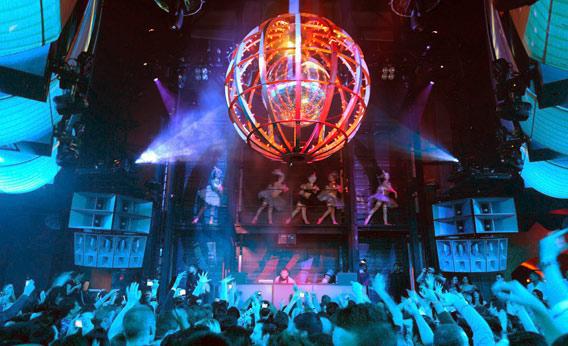A successful nightclub is often a hotspot that manages to bottle some fleeting notion of cool. Studio 54 in the disco ‘70s. Bungalow 8 in the Sex and the City aughts. But as the mastermind of massive club chains like Marquee, Tao, and Lavo, Noah Tepperberg has brought a new business model to nightlife. You might call it the Cheesecake Factory approach to clubbing.
Tepperberg would blanch at my comparison to the painfully bourgeois restaurant chain. But his big-box clubs rely on similar branding principles: Wherever patrons encounter them, they can expect a satisfying, consistent, mildly indulgent experience. “People know it will be glamour and bottle service and sheen and polish,” says Madison Moore, an American studies doctoral candidate at Yale who studies nightlife trends. “When you standardize a brand like Marquee has, it means you’re confirming that what people are buying into will be uniform wherever they go.”
The original Marquee opened in Lower Manhattan in 2003. It featured cavernous proportions, crowded banquettes, big-name DJs, and a steady flow of celebrity patrons (Paris Hilton, Usher, Lindsay Lohan). Still going strong after nine years, Marquee is now ancient by the standards of an industry in which trendy-for-a-nanosecond clubs can get shuttered after 18 months. At the end of 2010, Marquee expanded to Las Vegas, with a branch that soon became the top-grossing nightclub in the United States. This March, Marquee went global, opening a third outlet in Sydney, Australia. Tao and Lavo both have New York and Las Vegas venues, though they haven’t yet ventured abroad. “There’s no reason they shouldn’t be able to carry the brand overseas,” says Anita Elberse, a Harvard Business School professor who has studied the economics of clubbing. “Particularly with social media, it’s much easier for consumers to communicate to friends what they’re doing on a given night. And groups of friends extend all over the globe now.”
Elberse wrote a business school case study about Marquee’s operations. She was particularly impressed with the professionalism she encountered. “A lot of nightclub owners don’t even really look at it as a real business. Marquee makes sure to pay its promoters on time, to keep its promises, to carefully target and cater to its customers. That alone makes it stand out.”
But while a responsible, professional attitude may go far in most industry sectors, it is almost antithetical to the brand image of a stylish nightclub. Clubbing is indie rock and sketchy characters, not adult contemporary and boring business managers. By the very virtue of its success, Marquee runs the risk of Disney-fication—of becoming tame, predictable, and thus uncool.
Indeed, Marquee is not even close to the coolest club out there. It’s not exclusive enough (its spaces are huge, so it lets in lots of “muppets”—the club-world term for the unfabulous). It’s not raw enough (its professionalism dictates that it maintain a danger-free environment). It’s not organic enough (it uses hired entertainers and canned routines to spice up the dance floor). But some clubbers seek a more predictable, dependable, reined-in night. Marquee provides this, across multiple locations, and yet still maintains a veneer of hipness by ensuring that celebrities frequent its banquettes. As long as Kanye West is going to Marquee, the venue will be more than cool enough for the thrice-a-year club-goer. “Once the broader public knows about a club and tries to get in, it’s kind of on the outs,” says Lauren Rivera, an assistant professor at Northwestern’s Kellogg School of Management. “It loses cachet. But Marquee has branded itself through its association with celebrities. The Chateau Marmont has been around forever, and people know what it is, but it has a strong celebrity presence and so it still has cachet.”
Other clubs have previously gone global. Pacha, which began in Spain, even posts a page on its website with information for potential new franchisees. (I asked an acquaintance who has attended multiple Pachas what their unifying theme was. She answered, “Drugs.”) Limelight bounced around to different cities in its heyday, and SoHo House allows jet-setting scenesters to gather and blow off steam in various locales. But with its carefully choreographed lightshows, premium but reasonable pricing, and consistent product, Marquee seems like the first brand with real potential to do for nightclubs what Starbucks did for coffee shops. It’s not hard to imagine a rapid succession of new Marquees opening in Singapore, Dubai, Moscow.
It will be interesting to see if, like other global brands, Marquee is eventually forced to adapt around the edges to each local context—the way international fast-food chains alter their menus to satisfy regional diet eccentricities. Already, Tepperberg says, the Sydney Marquee is dealing with translation issues. “Nobody knows what bottle service is over there,” he chuckles, referring to Marquee’s most profitable activity, in which patrons buy full bottles of liquor at absurd markups. “We have to educate people.”
